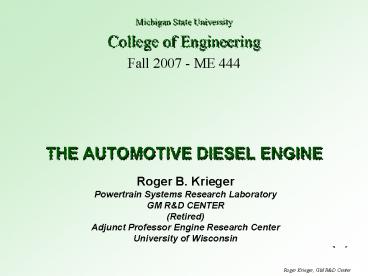THE AUTOMOTIVE DIESEL ENGINE - PowerPoint PPT Presentation
1 / 33
Title:
THE AUTOMOTIVE DIESEL ENGINE
Description:
Summary & future trends. Roger Krieger, GM R&D Center. The ... Electric motor driven compressor, turbine, or both. Dual range compressors with one turbine ... – PowerPoint PPT presentation
Number of Views:329
Avg rating:3.0/5.0
Title: THE AUTOMOTIVE DIESEL ENGINE
1
THE AUTOMOTIVE DIESEL ENGINE
Michigan State University College of
Engineering Fall 2007 - ME 444
- Roger B. Krieger
- Powertrain Systems Research Laboratory
- GM RD CENTER
- (Retired)
- Adjunct Professor Engine Research Center
- University of Wisconsin
2
Diesel History
3
Lecture Outline
- Overview
- Combustion systems
- Fuel injection systems
- Fuel characteristics
- Performance issues
- Emissions control
- Summary future trends
4
The Diesel Engine
.... an internal combustion engine in which air
is compressed to a temperature sufficiently high
to ignite fuel injected into the cylinder where
the combustion actuates a piston.
Websters Dictionary
5
Diesel Combustion
- Fuel sprayed in cylinder near TDC
- Atomization, vaporization mixing delay ignition
- Ignition occurs wherever conditions right
- Combustion rate controlled by injection
characteristics (injection rate, spray angle,
injection pressure, nozzle size and shape),
chamber shape, mixture motion, turbulence - Glow plug may be used to aid cold starting
- Power output controlled only by amount of fuel
injected
6
(No Transcript)
7
(No Transcript)
8
(No Transcript)
9
Lecture Outline
- Overview
- Combustion systems
- Fuel injection systems
- Fuel characteristics
- Performance issues
- Emissions control
- Summary future trends
10
Typical DI Chambers
Spray Outline
Heavy duty - 4-valve, central injector, low
swirl, wide shallow bowl
Light duty - 4-valves, central vertical injector,
high swirl, deep narrow bowl
11
Lecture Outline
- Overview
- Combustion systems
- Fuel injection systems
- Fuel characteristics
- Performance issues
- Pressure-volume comparisons
- Emissions control
- Summary future trends
12
Fuel Injection Systems
- Electronic distributor pump
- Electronic unit injector (EUI)
- High-pressure common rail
13
Electronic Distributor Pump
14
Electronic Unit Injector (EUI)
15
High-Pressure Common Rail
Common Rail
Spill Control Valve
Injectors
Fuel Return to Tank
ECU
High-Pressure Pump
16
Lecture Outline
- Overview
- Combustion systems
- Fuel injection systems
- Fuel characteristics
- Performance issues
- Emissions control
- Summary future trends
17
Fuel Characteristics
18
Lecture Outline
- Overview
- Combustion systems
- Fuel injection systems
- Fuel characteristics
- Performance issues
- Emissions control
- Summary future trends
19
(No Transcript)
20
(No Transcript)
21
P-V Diagrams
22
Boosting
- Most diesels boosted (i.e., turbocharged)
- Boosting helps power torque
- Boosting helps fuel consumption
- Boosting facilitates torque curve shaping
- Boosting helps relative package size
- Boosting increases cost but is good value
23
Boosting Systems
- Current Technologies
- Waste-gate turbocharger
- Variable nozzle turbine turbocharger
- Future Technologies
- Two-stage turbocharging systems
- Electric motor driven compressor, turbine, or
both - Dual range compressors with one turbine
24
Lecture Outline
- Overview
- Combustion systems
- Fuel injection systems
- Fuel characteristics
- Performance issues
- Emissions control
- Summary future trends
25
Progression in European Passenger Car Diesel
Emissions Standards
Efficiency
Power Density
Driveability
26
Exhaust Emission Control
- HC (challenging)
- Nozzle design
- Catalyst (HC exhaust odor)
- CO (less challenging)
- NOx (most challenging)
- Injection timing
- EGR
- Injection rate shaping
- Lean NOx catalyst
- Combustion chamber shape optimization
27
Exhaust Emission Control
- Particulates (very challenging)
- Chamber symmetry and shape
- Injection characteristics (mixing rates)
- Oil control
- Catalyst (soluble fraction)
- Particulate trap
- Odor (oxidation catalyst)
- Co2 (global warming)
28
Combustion Development
- Optimize piston bowl shape to control
spray/airflow interaction - Increase combustion rate
FUEL SPRAY
FUEL VAPOR
REVERSE SQUISH
SPRAY ON BOWL LIP
SOOT CLOUD
FUEL FILM ON WALL
SWIRL DIRECTION
29
Low-Temperature Combustion
Low NOx/Soot Region
Conventional Combustion
Toward LTC
0 1 2 3 4 5
6
Equivalence Ratio
30
Exhaust Aftertreatment
ECU
EGR VALVE
AIR FLOW METER
THROTTLE
DOC
PARTICLE FILTER
NOx DEVICE
DOC
VAPORIZER
TEMPERATURE SENSORS
PRESSURE DROP SENSOR
31
Lecture Outline
- Overview
- Combustion systems
- Fuel injection systems
- Fuel characteristics
- Performance issues
- Emissions control
- Summary future trends
32
Summary Diesel Engines
- Advantages
- Efficiency (most efficient prime mover)
- Emissions (low CO, CO2, good durability)
- Very high torque and performance
- Disadvantages
- Emissions (more challenging to control NOx,
particulates) - Higher cost
- Heavier
- Noise (more challenging to make quiet)
33
Future Trends
- Factors
- Global warming (favors diesel)
- Energy resources (favors diesel)
- Government policy (low fuel tax unfavorable for
diesel) - USA
- Truck use increasing
- Car use discouraged by low fuel tax
- Higher recent fuel prices and higher CAFE threat
driving some introduction - Europe
- New technology (4-valve DI, common-rail
injection, particulate traps) - Diesel car sales up dramatically (currently 50
of new car market) - Being marketed as performance engine































